The Black Sea Physics Analysis and Forecasting System within the Framework of the Copernicus Marine Service
Abstract
:1. Introduction
2. System Description
2.1. Ocean Numerical Model
2.2. Data Assimilation Scheme
2.3. Operational Chain
3. Quality Assessment of the Operational System
- The difference between the analysis and the forecast (AF):
- The difference between the forecast and the persistence (PF):
3.1. Sea Surface Temperature
3.2. Sea Surface Height
3.3. Temperature and Salinity
3.3.1. Analysis Quality
3.3.2. Forecast Assessment
4. Black Sea Diagnostics and Circulation Consistency
4.1. Temporal Evolution of the CIL and Stratification
4.2. Circulation
5. Conclusions
Author Contributions
Funding
Institutional Review Board Statement
Informed Consent Statement
Data Availability Statement
Conflicts of Interest
Appendix A
- Zonal and Meridional components of the 10 m winds, expressed as ms−1.
- Total Cloud Cover, expressed as %.
- 2 m Air Temperature, expressed as K degrees.
- 2 m Dew Point Temperature, expressed as K degrees.
- Total Precipitation, expressed as kg/m2/s.
- Mean Sea Level Pressure, expressed as hPa.
References
- Pinardi, N.; Cavaleri, L.; Coppini, G.; De Mey, P.; Fratianni, C.; Huthnance, J.; Lermusiaux, P.F.J.; Navarra, A.; Preller, R.; Tibaldi, S. From weather to ocean predictions: An historical viewpoint. J. Mar. Res. 2017, 75, 103–159. [Google Scholar] [CrossRef] [Green Version]
- Brassington, G.B. Forecast Terrors, goodness and verification in Ocean forecasting. J. Mar. Res. 2017, 75, 403–433. [Google Scholar] [CrossRef]
- Le Traon, P.Y.; Reppucci, A.; Alvarez Fanjul, E.; Aouf, L.; Behrens, A.; Belmonte, M.; Bentamy, A.; Bertino, L.; Brando, V.E.; Kreiner, M.B.; et al. From Observation to Information and Users: The Copernicus Marine Service Perspective. Front. Mar. Sci. 2019, 6, 234. [Google Scholar] [CrossRef] [Green Version]
- Pinardi, N.; Coppini, G. Operational oceanography in the Mediterranean Sea: The second stage of development. Ocean Sci. 2010, 6, 263–267. [Google Scholar] [CrossRef] [Green Version]
- Clementi, E.; Oddo, P.; Drudi, M.; Pinardi, N.; Korres, G.; Grandi, A. Coupling hydrodynamic and wave models: First step and sensitivity experiments in the Mediterranean Sea. Ocean. Dyn. 2017, 67, 1293–1312. [Google Scholar] [CrossRef] [Green Version]
- Palazov, A.; Ciliberti, S.A.; Peneva, E.; Gregoire, M.; Staneva, J.; Lemieux-Dudon, B.; Masina, S.; Pinardi, N.; Vandenbulcke, L.; Behrens, A.; et al. Black Sea Observing System. Front. Mar. Sci. 2019, 6, 1–8. [Google Scholar] [CrossRef]
- Madec, G.; The NEMO Team. NEMO Ocean Engine, Note du Pôle de Modélisation; Institute Pierre-Simon Laplace (IPSL): Paris, France, 2008; ISSN 1288–1619. [Google Scholar]
- Stanev, E.V.; Rachev, N.H. Numerical study on the planetary Rossby waves in the Black Sea. J. Mar. Syst. 1999, 21, 283–306. [Google Scholar] [CrossRef]
- Historical GEBCO Data Sets. Available online: https://www.gebco.net/data_and_products/historical_data_sets/#gebco_one (accessed on 1 April 2021).
- Wessel, P.; Smith, W.H.G. A global, self-consistent, hierarchical, high-resolution shoreline database. J. Geophys. Res. 1996, 101, 8741–8743. [Google Scholar] [CrossRef] [Green Version]
- Pettenuzzo, D.; Large, W.G.; Pinardi, N. On the corrections of ERA-40 surface flux products consistent with the Mediterranean heat and water budgets and the connection between basin surface total heat flux and NAO. J. Geophys. Res. 2010, 115, C06022. [Google Scholar] [CrossRef]
- Roullet, G.; Madec, G. Salt conservation, free surface, and varying levels: A new formulation for ocean general circulation models. J. Geophys. Res. 2000, 105, 23927–23942. [Google Scholar] [CrossRef]
- Jarosz, E.; Teague, W.J.; Book, J.W.; Beşiktepe, Ş. On flow variability in the Bosphorus Strait. J. Geophys. Res. 2011, 116, C08038. [Google Scholar] [CrossRef] [Green Version]
- Özsoy, E.; Altıok, H.A. Review of Hydrography of the Turkish Straits System. In The Sea of Marmara-Marine Biodiversity, Fisheries, Conservation and Governance; Özsoy, E., Çağatay, N.M., Balkis, N., Öztürk, B., Eds.; Turkish Marine Research Foundation (TÜDAV): Istanbul, Turkey, 2016; Publication #42. [Google Scholar]
- Özsoy, E.; Çağatay, N.M.; Balkis, N.; Öztürk, B. Review of Water Fluxes across the Turkish Straits System. In The Sea of Marmara-Marine Biodiversity, Fisheries, Conservation and Governance; Özsoy, E., Altiok, H., Eds.; Turkish Marine Research Foundation (TÜDAV): Istanbul, Turkey, 2016; Publication #42. [Google Scholar]
- Stanev, E.V.; Peneva, E.; Chtirkova, B. Climate change and regional ocean water mass disappearance: Case of the Black Sea. J. Geophys. Res. 2019, 124, 4803–4819. [Google Scholar] [CrossRef]
- Ünlüata, Ü.; Oğuz, T.; Latif, M.A.; Özsoy, E. On the physical oceanography of the Turkish Straits. In The Physical Oceanography of Sea Straits; NATO/ASI Series; Kluwer: Dordrecht, The Netherlands, 1990; pp. 25–60. [Google Scholar]
- Kara, A.B.; Wallcraft, A.J.; Hurlburt, H.E.; Stanev, E.V. Airsea fluxes and river discharges in the Black Sea with a focus on the Danube and Bosphorus. J. Mar. Syst. 2008, 74, 74–95. [Google Scholar] [CrossRef]
- Pinardi, N.; Bonaduce, A.; Navarra, A.; Dobricic, S.; Oddo, P. The mean sea level equation and its application to the Mediterranean Sea. J. Clim. 2014, 27, 442–447. [Google Scholar] [CrossRef]
- Stanev, E.V.; Beckers, J.M. Barotropic and baroclinic oscillations in strongly stratified ocean basins. Numerical study for the Black Sea. J. Mar. Syst. 1999, 19, 65–112. [Google Scholar] [CrossRef]
- Ludwig, W.; Dumont, E.; Meybeck, M.; Heussner, S. River discharges of water and nutrients to the Mediterranean Sea: Major drivers for ecosystem changes during past and future decades? Prog. Oceanogr. 2009, 80, 199–217. [Google Scholar] [CrossRef]
- Dobricic, S.; Pinardi, N. An oceanographic three-dimensional variational data assimilation scheme. Ocean Model. 2008, 22, 89–105. [Google Scholar] [CrossRef]
- Storto, A.; Dobricic, S.; Masina, S.; Di Pietro, P. Assimilating along-track altimetric observations through local hydrostatic adjustment in a global ocean variational assimilation system. Mon. Weather Rev. 2010, 139, 738–754. [Google Scholar] [CrossRef] [Green Version]
- Waters, J.; Lea, D.J.; Martin, M.J.; Mirouze, I.; While, J. Implementing a variational data assimilation system in an operational 1/4 degree global ocean model. Q. J. R. Meteorol. 2014, 141, 333–349. [Google Scholar] [CrossRef]
- Clementi, E.; Pistoia, J.; Escudier, R.; Delrosso, D.; Drudi, M.; Grandi, A.; Lecci, R.; Cretí, S.; Ciliberti, S.; Coppini, G.; et al. Mediterranean Sea Analysis and Forecast (CMEMS MED-Currents, EAS5 System) [Data Set]; Copernicus Monitoring Environment Marine Service (CMEMS); Centro Euro-Mediterraneo sui Cambiamenti Climatici (CMCC): Lecce, Italy, 2019; Available online: https://doi.org/10.25423/CMCC/MEDSEA_ANALYSIS_FORECAST_PHY_006_013_EAS5 (accessed on 9 December 2021).
- Murphy, A.H. What is a good forecast? An essay on the nature of goodness in weather forecasting. Weather Forecast. 1993, 8, 281–293. [Google Scholar] [CrossRef] [Green Version]
- Tonani, M.; Pinardi, N.; Fratianni, C.; Pistoia, J.; Dobricic, S.; Pensieri, S.; de Alfonso, M.; Nittis, K. Mediterranean Forecasting System: Forecast and analysis assessment through skill scores. Ocean Sci. 2009, 5, 649–660. [Google Scholar] [CrossRef] [Green Version]
- Ciliberti, S.A.; Peneva, E.L.; Jansen, E.; Martins, D.; Cretí, S.; Stefanizzi, L.; Lecci, R.; Palermo, F.; Daryabor, F.; Lima, L.; et al. Black Sea Analysis and Forecast (CMEMS BS-Currents, EAS3 System) (Version 1) [Data Set]; Copernicus Monitoring Environment Marine Service (CMEMS); Centro Euro-Mediterraneo sui Cambiamenti Climatici (CMCC): Lecce, Italy, 2020; Available online: https://doi.org/10.25423/CMCC/BLKSEA_ANALYSIS_FORECAST_PHYS_007_001_EAS3 (accessed on 9 December 2021).
- Özsoy, E.; Ünlüata, Ü. Oceanography of the Black Sea: A review of some recent results. Earth-Sci. Rev. 1997, 42, 231–272. [Google Scholar] [CrossRef]
- Staneva, J.V.; Stanev, E.V. Oceanic response to atmospheric forcing derived from different climatic data sets. Intercomparison study for the Black Sea. Oceanol. Acta 1998, 21, 393–417. [Google Scholar] [CrossRef] [Green Version]
- Gunduz, M.; Özsoy, E.; Hordoir, R. A model of Black Sea circulation with strait exchange (2008–2018). Geosci. Model Dev. 2020, 13, 121–138. [Google Scholar] [CrossRef] [Green Version]
- Castellari, S.; Pinardi, N.; Leaman, K. A model study of air-sea interactions in the Mediterranean Sea. J. Mar. Syst. 1998, 18, 89–114. [Google Scholar] [CrossRef]
- Reed, R.K. On estimating insolation over the ocean. J. Phys. Oceanogr. 1977, 7, 482–485. [Google Scholar] [CrossRef] [Green Version]
- Payne, R.E. Albedo of the sea surface. J. Atmos. Sci. 1972, 29, 959–970. [Google Scholar] [CrossRef]
- Rosati, A.; Miyakoda, K. A general circulation model for upper ocean simulation. J. Phys. Oceanogr. 1988, 18, 1601–1626. [Google Scholar] [CrossRef]
- Lowe, P.R. An approximating polynomial for the computation of saturation vapor pressure. J. Appl. Meteorol. 1977, 16, 100–103. [Google Scholar] [CrossRef] [Green Version]
- Bignami, F.; Marullo, S.; Santoleri, R.; Schiano, M.E. Long wave radiation budget on the Mediterranean Sea. J. Geophys. Res. 1995, 100, 2501–2514. [Google Scholar] [CrossRef]
- Kondo, J. Air-sea bulk transfer coefficients in diabatic condition. Bound. Layer Meteorol. 1975, 9, 91–112. [Google Scholar] [CrossRef]
- Hellerman, S.; Rosenstein, M. Normal monthly wind stress over the world ocean with error estimates. J. Phys. Oceanogr. 1983, 23, 1009–1039. [Google Scholar] [CrossRef] [Green Version]
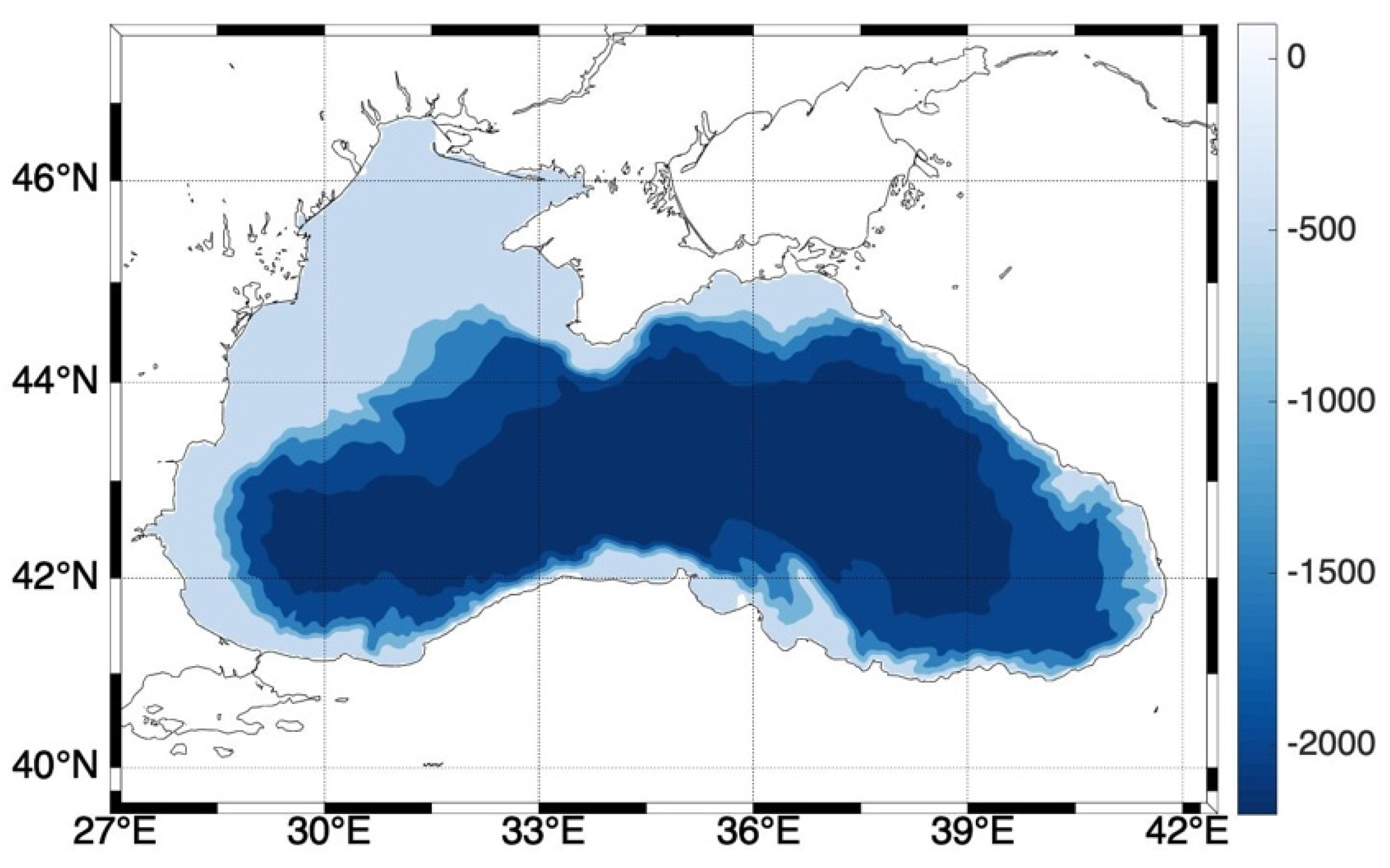

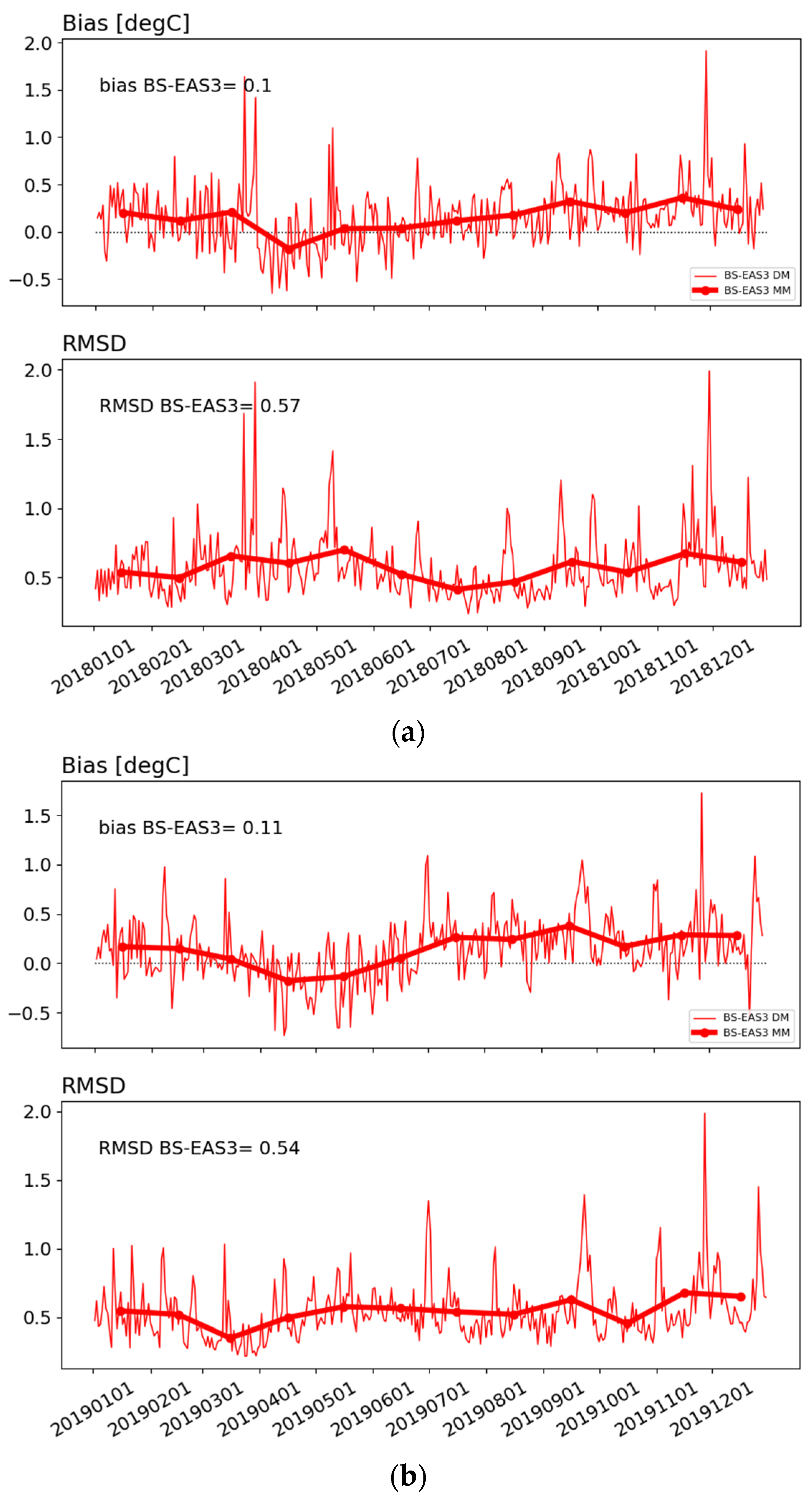
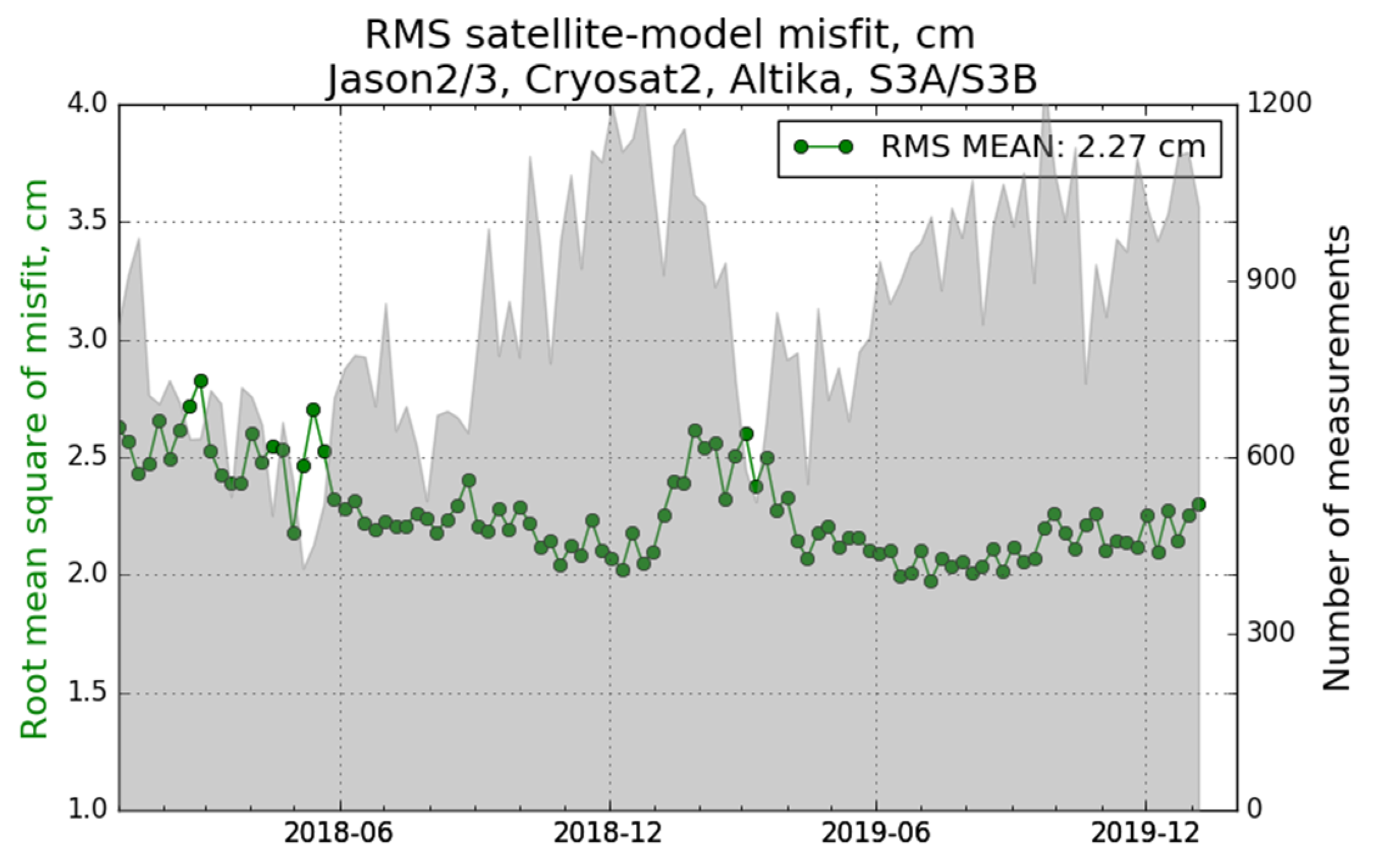
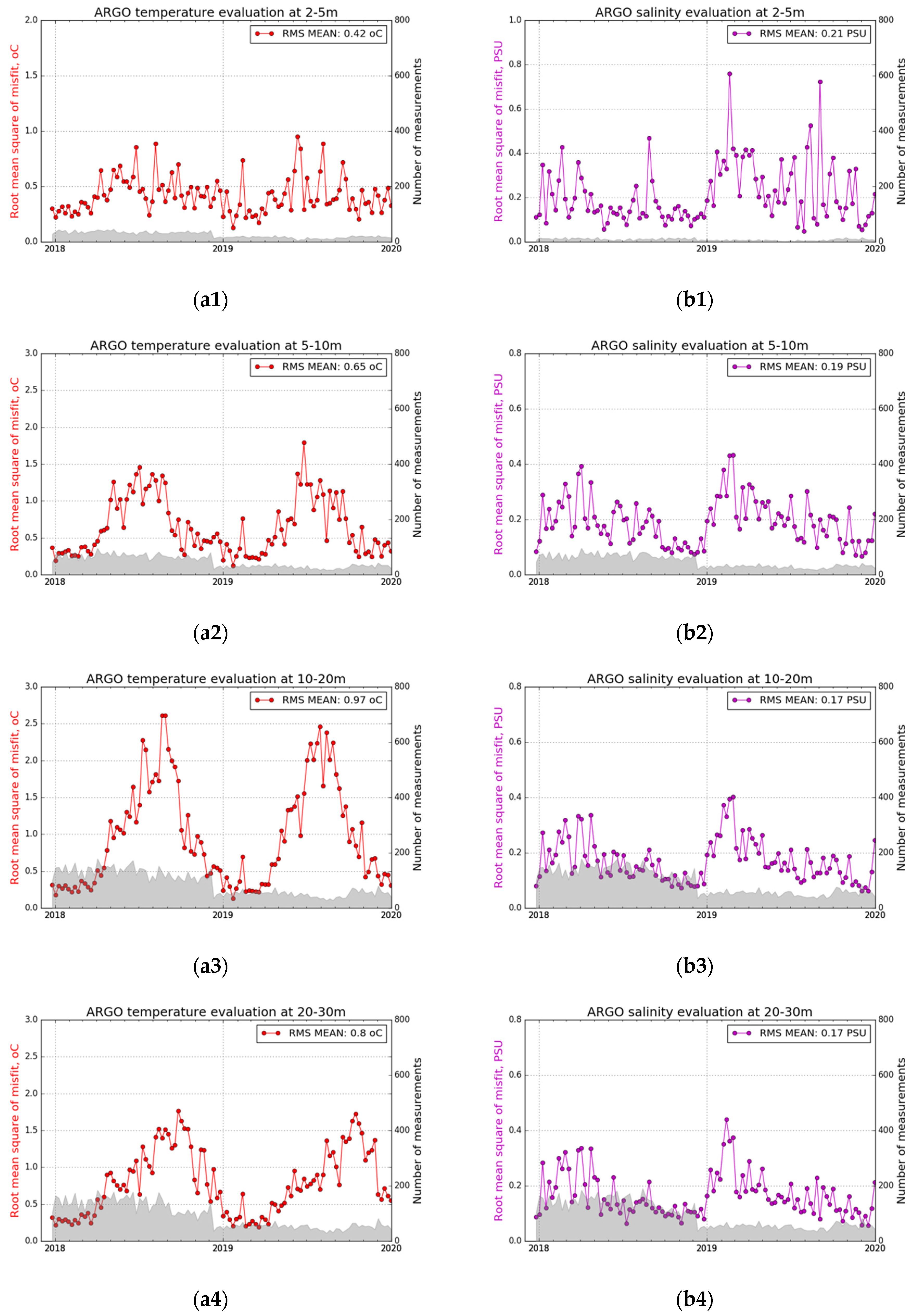
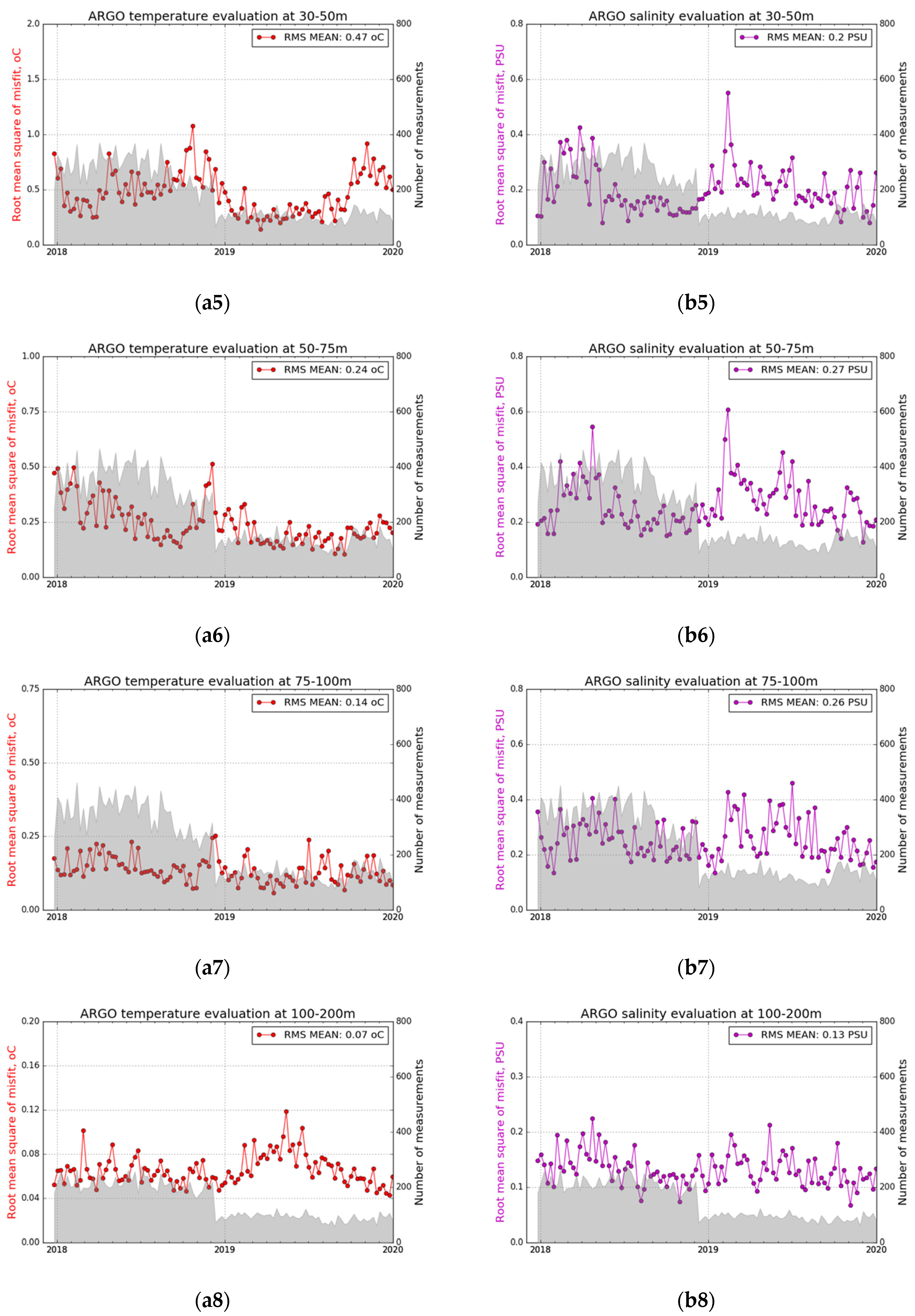
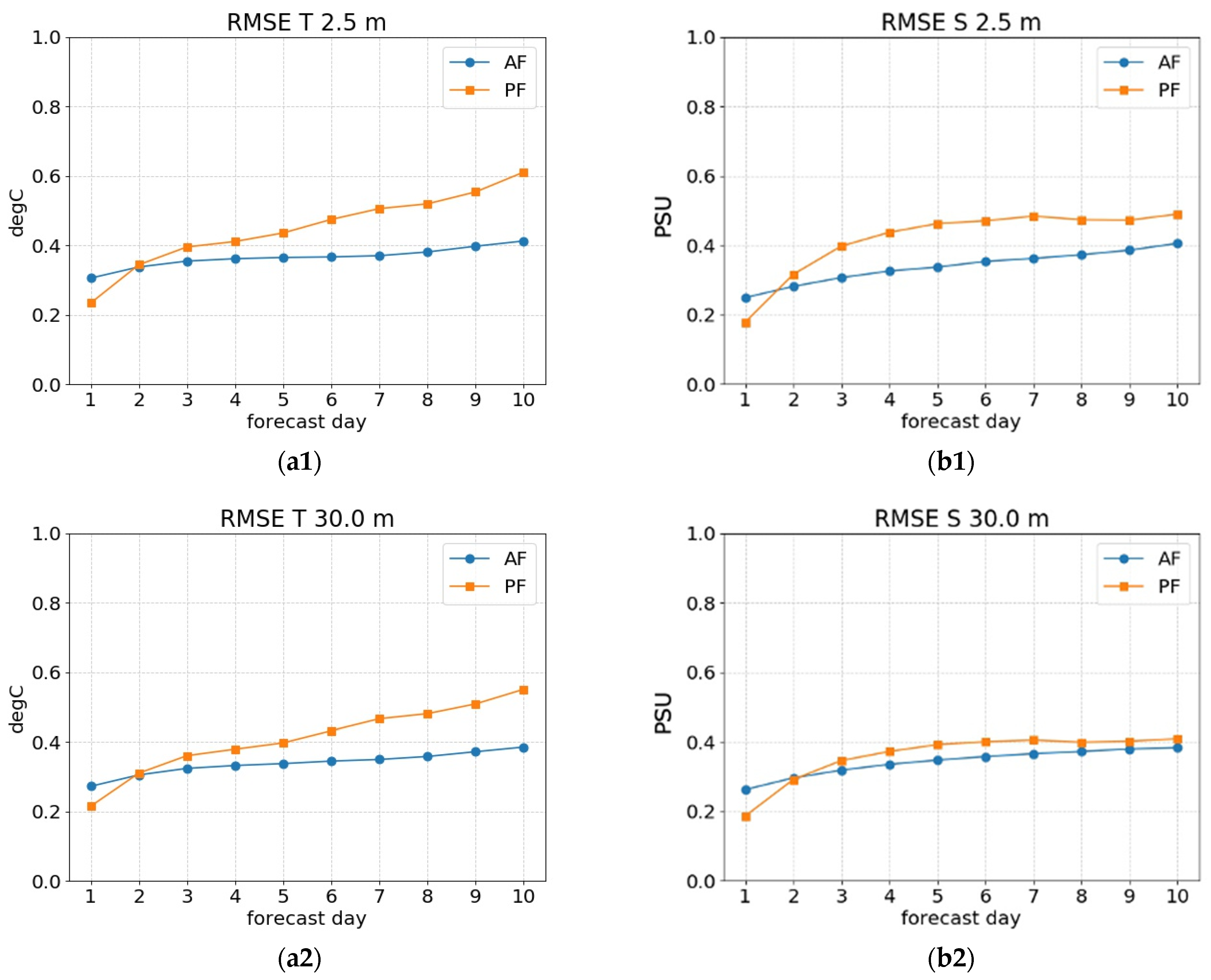
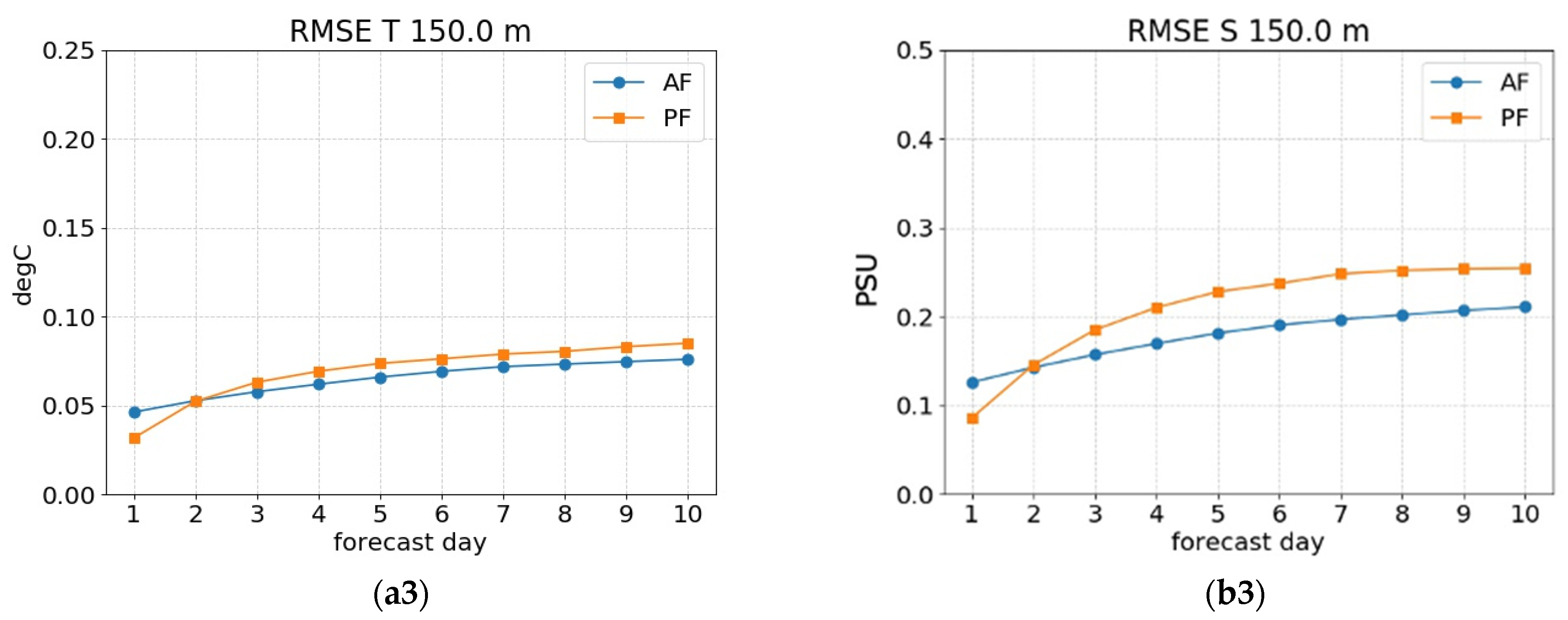
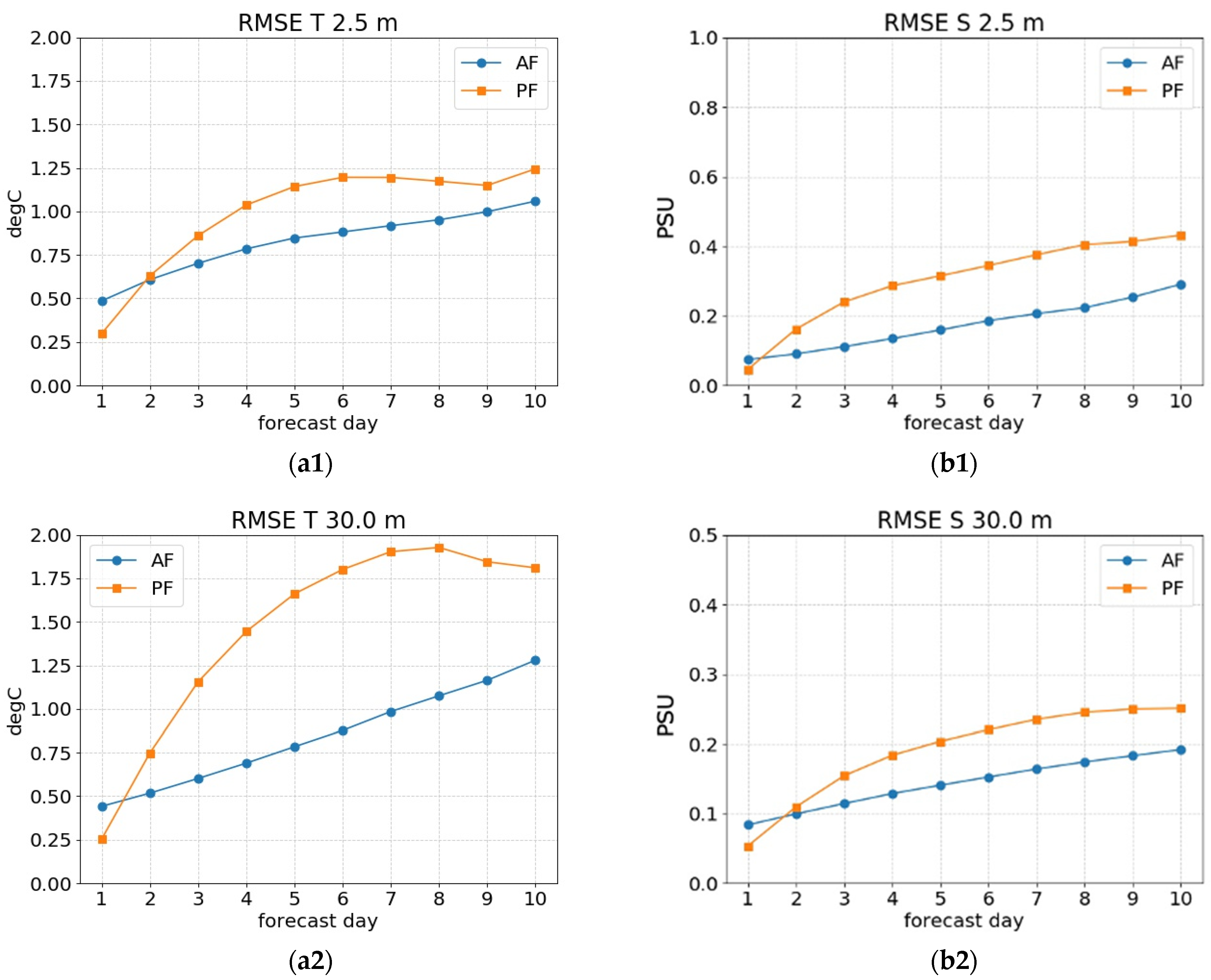
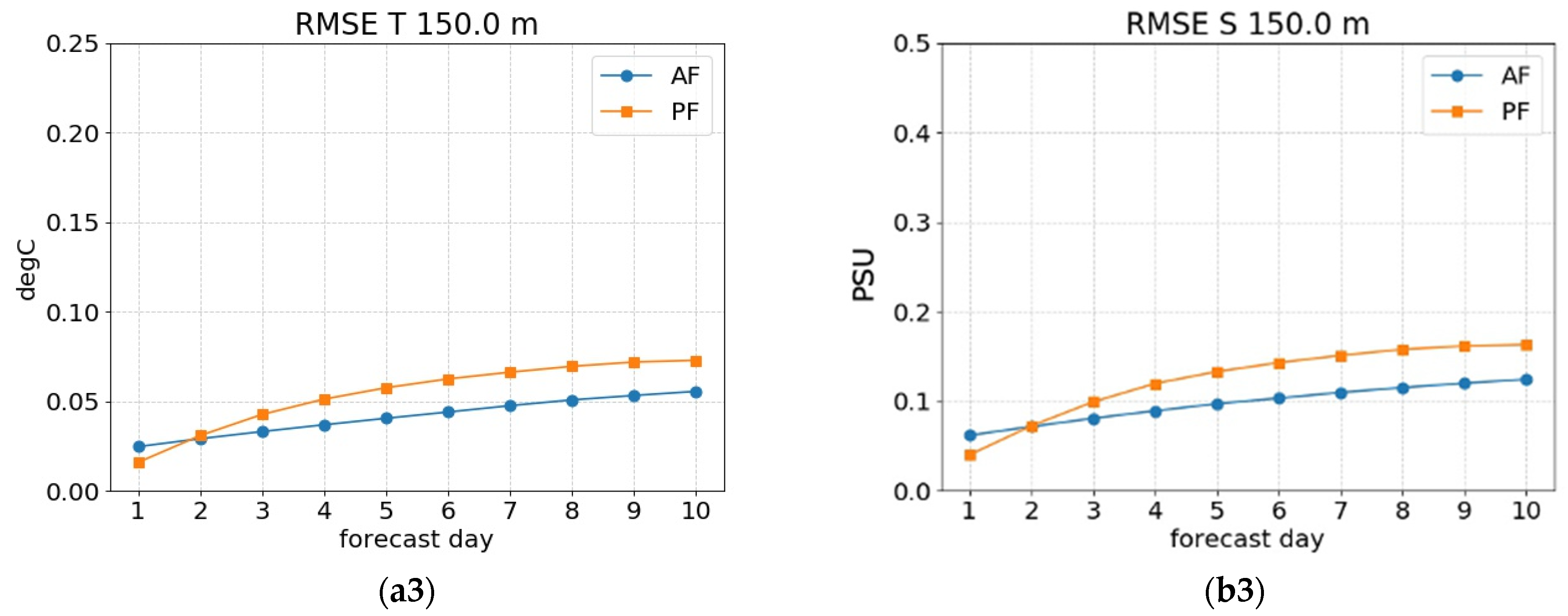
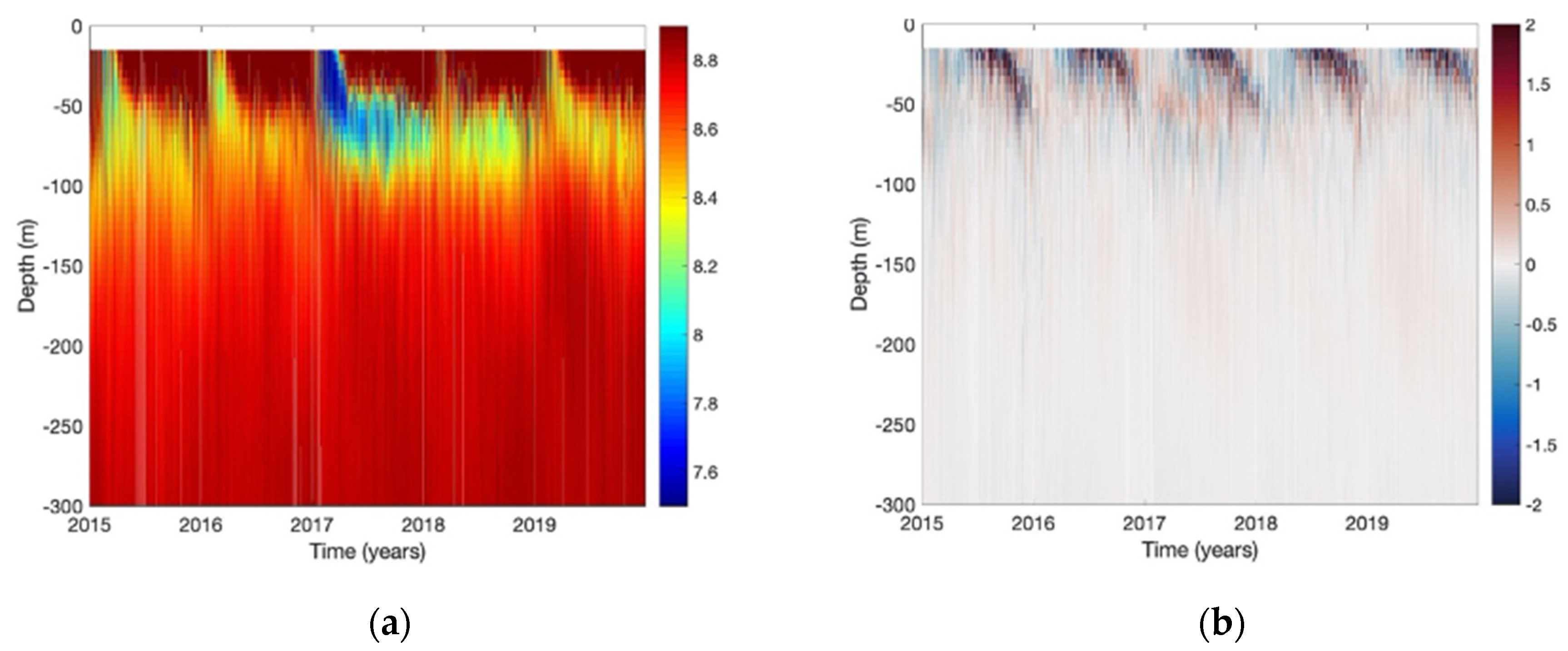
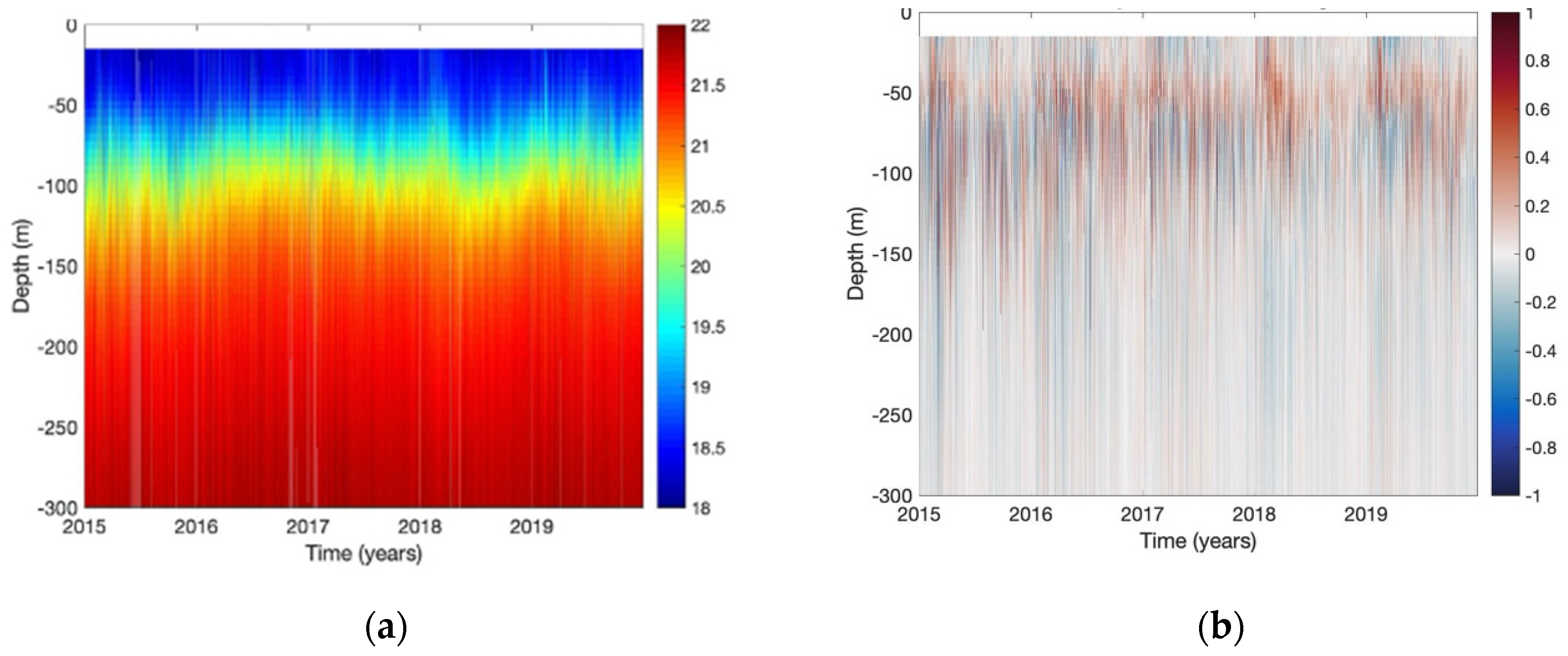
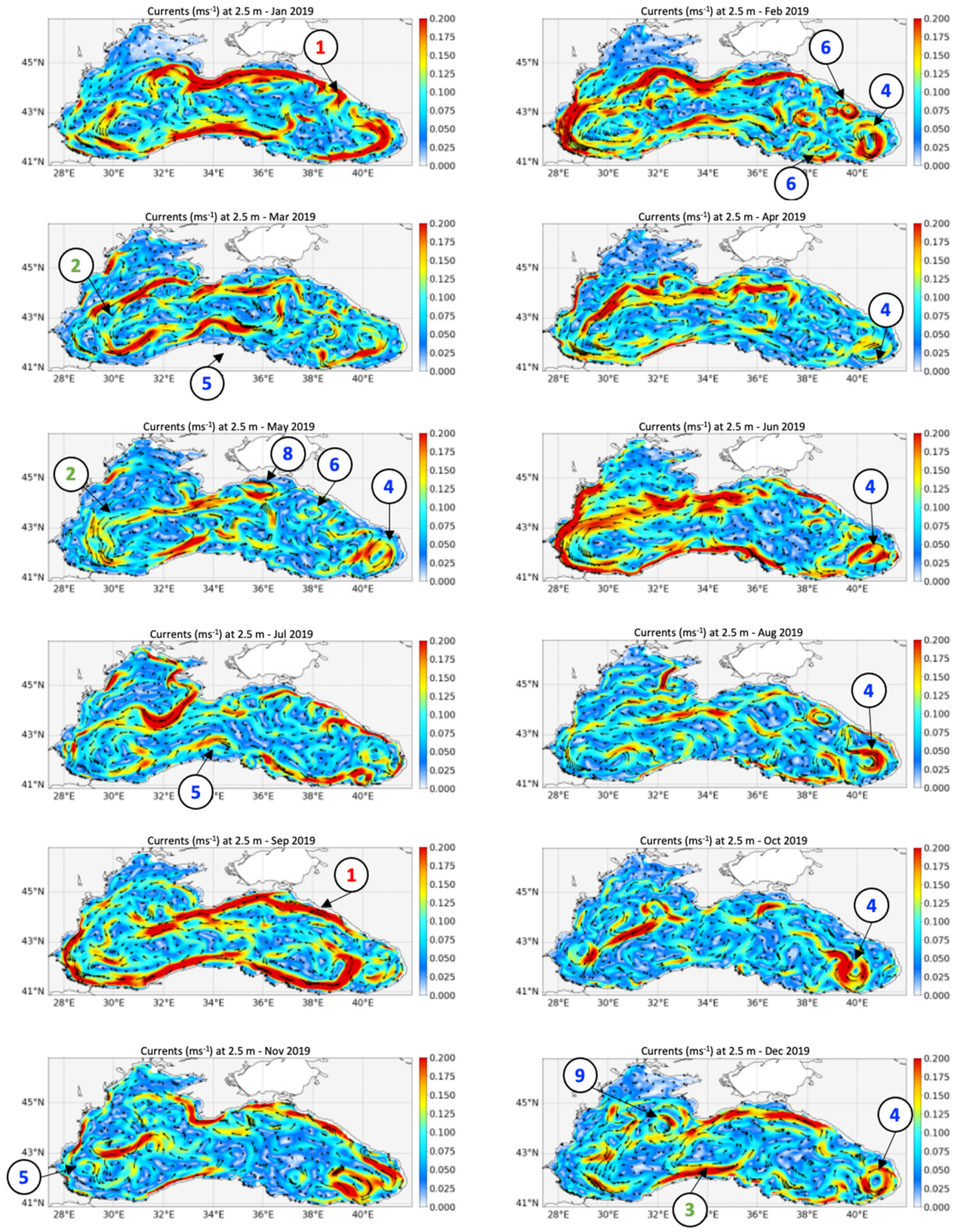
| Product Reference | Platforms/Satellite | Upstream Reference | Usage |
|---|---|---|---|
| Temperature and Salinity profiles | ARGO | INSITU_BS_NRT_ OBSERVATIONS_013_034 | Validation, Assimilation |
| Sea Surface Temperature (SST) | SLSTR and AVHRR on Sentinel-3A and 3B, and NOAA, VIIRS, MetOp-B, MODIS AQUA, TERRA and SEVIRI on board of MSG satellite | SST_BS_SST_L4_NRT_OBSERVATIONS_010_006 | Assimilation |
| SST_BS_SST_L3S_NRT_OBSERVATIONS_010_013 | Validation | ||
| Along track Sea Level Anomaly (SLA) | Altika Cryosat-2 H2B Jason-2 Jason-3 Sentinel-3A Sentinel-3B | SEALEVEL_EUR_PHY_L3_NRT_ OBSERVATIONS_008_059 from CMEMS | Validation, Assimilation |
| Layer (m) | T RMSE Misfit (°C) | S RMSD Misfit (PSU) |
|---|---|---|
| 2–5 | 0.42 | 0.21 |
| 5–10 | 0.65 | 0.19 |
| 10–20 | 0.97 | 0.17 |
| 20–30 | 0.80 | 0.17 |
| 30–50 | 0.47 | 0.20 |
| 50–75 | 0.24 | 0.27 |
| 75–100 | 0.14 | 0.26 |
| 100–200 | 0.07 | 0.13 |
| 200–500 | 0.02 | 0.05 |
Publisher’s Note: MDPI stays neutral with regard to jurisdictional claims in published maps and institutional affiliations. |
© 2022 by the authors. Licensee MDPI, Basel, Switzerland. This article is an open access article distributed under the terms and conditions of the Creative Commons Attribution (CC BY) license (https://creativecommons.org/licenses/by/4.0/).
Share and Cite
Ciliberti, S.A.; Jansen, E.; Coppini, G.; Peneva, E.; Azevedo, D.; Causio, S.; Stefanizzi, L.; Creti’, S.; Lecci, R.; Lima, L.; et al. The Black Sea Physics Analysis and Forecasting System within the Framework of the Copernicus Marine Service. J. Mar. Sci. Eng. 2022, 10, 48. https://doi.org/10.3390/jmse10010048
Ciliberti SA, Jansen E, Coppini G, Peneva E, Azevedo D, Causio S, Stefanizzi L, Creti’ S, Lecci R, Lima L, et al. The Black Sea Physics Analysis and Forecasting System within the Framework of the Copernicus Marine Service. Journal of Marine Science and Engineering. 2022; 10(1):48. https://doi.org/10.3390/jmse10010048
Chicago/Turabian StyleCiliberti, Stefania A., Eric Jansen, Giovanni Coppini, Elisaveta Peneva, Diana Azevedo, Salvatore Causio, Laura Stefanizzi, Sergio Creti’, Rita Lecci, Leonardo Lima, and et al. 2022. "The Black Sea Physics Analysis and Forecasting System within the Framework of the Copernicus Marine Service" Journal of Marine Science and Engineering 10, no. 1: 48. https://doi.org/10.3390/jmse10010048






